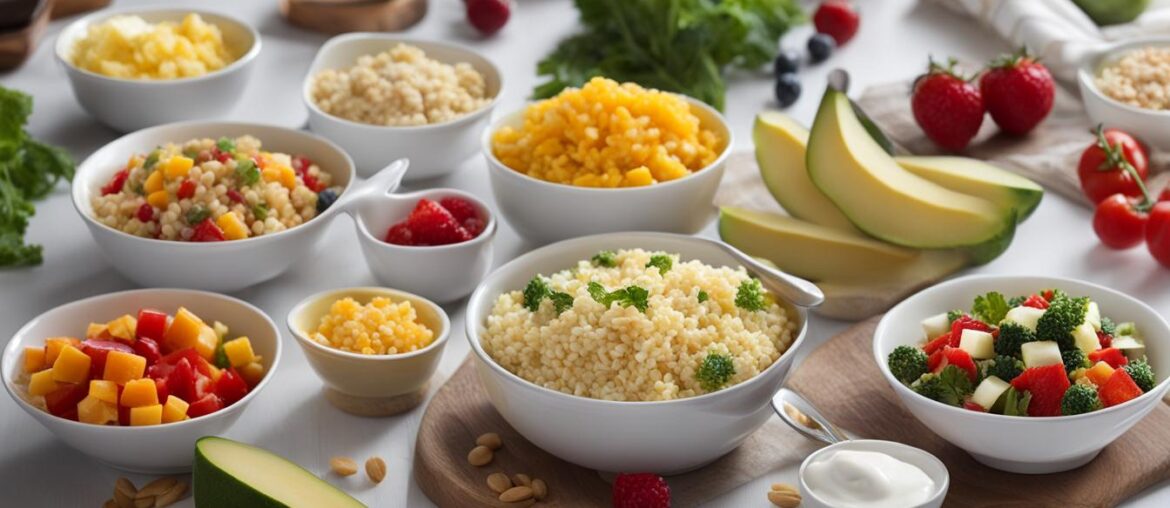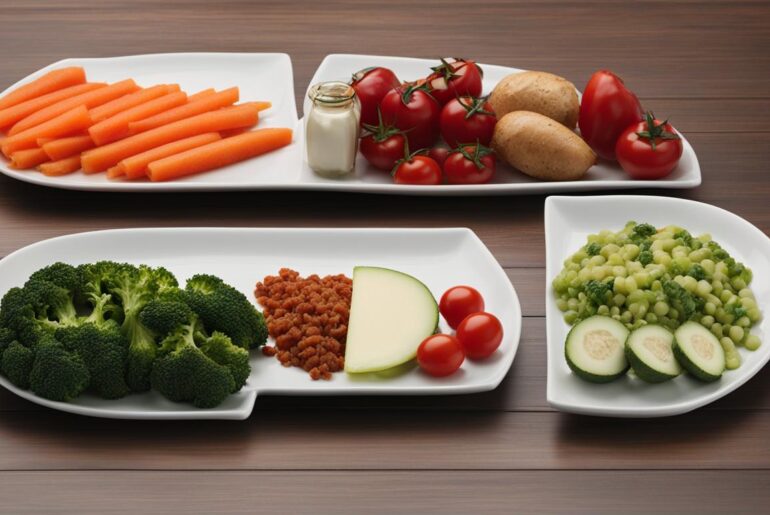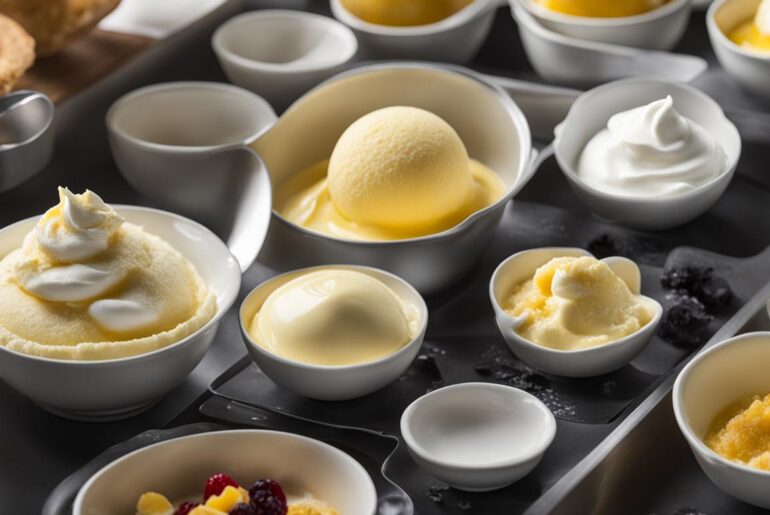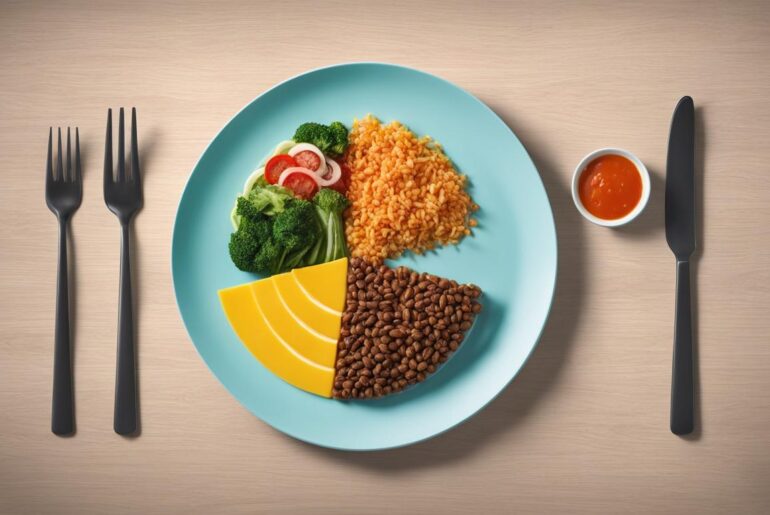Meal planning with portion control in mind is a crucial aspect of maintaining a healthy lifestyle. By being mindful of your portion sizes, you can ensure that you’re consuming balanced meals and avoiding overeating. Incorporating portion control strategies into your meal planning routine can help you achieve your health and wellness goals (see my post here).
- Meal planning with portion control is essential for maintaining a healthy lifestyle.
- Using a smaller plate can help trick your brain into feeling satisfied with a standard-sized portion.
- Measuring cups can be an excellent tool for accurately portioning your meals.
- Be selective with seconds, opting for healthier options like fruits instead of high-calorie desserts.
- Checking food labels for portion sizes can help you make informed choices.
Use a Smaller Plate
When it comes to portion control, the size of your plate matters. Using a smaller plate can have a significant impact on your portion size and overall eating habits. How does it work? Let me explain.
When you have a larger plate, it’s easier to fill it up with more food. Your brain is wired to perceive an empty plate as a signal that you need more food to feel satisfied. As a result, you may end up overeating and consuming more calories than your body needs.
Using a smaller plate tricks your brain into feeling satisfied with a standard-sized portion. When you visually see a plate that is full, even if the portion size is smaller, your brain registers it as an adequate amount of food. This helps prevent overeating and promotes portion control.
Imagine sitting down to a meal with a portion size that’s just right for you. By using a smaller plate, you’re taking a proactive step towards controlling your portion sizes and making healthier choices. It’s a simple and effective strategy that can make a big difference in your eating habits.
So, the next time you sit down for a meal, try using a smaller plate. You’ll be surprised at how satisfied you feel with a standard-sized portion. With portion control plate, you can take control of your portion size and make a positive change for your health.
| Benefits of Using a Smaller Plate | Tips for Using a Smaller Plate |
|---|---|
|
|
Try Measuring Cups
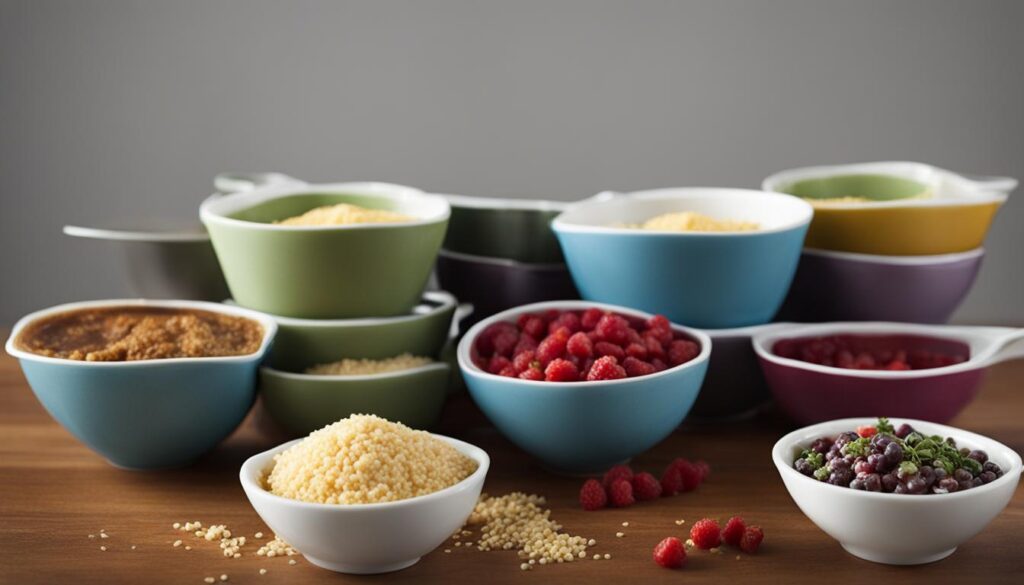
If you find it difficult to gauge the right amount of food to eat, try using measuring cups (check out my post on using measuring cups here). You don’t need special portion control containers – regular measuring cups or even teacups can work just fine. Measuring your portions can help you consistently eat the right amount each time.
When it comes to portion control, precision is key. Using measuring cups ensures that you are accurately measuring your food intake and preventing overeating. Whether it’s rice, pasta, or even snacks, measuring cups provide a simple yet effective way to control your portion sizes.
Here are some portion sizes that you can measure using cups:
| Food | Portion Size |
|---|---|
| Rice | ½ cup |
| Pasta | 1 cup |
| Cereal | 1 cup |
| Snacks (chips, pretzels) | 1 ounce or about 15-20 pieces |
| Nuts | 1 ounce or about a handful |
By using measuring cups, you can have better control over your portion sizes and avoid mindlessly consuming more than you need. Remember, portion control is about finding the right balance and fueling your body with the nutrients it needs, without overindulging.
Don’t worry if you don’t have measuring cups specifically labeled for portion control. Regular measuring cups from your kitchen can serve the purpose just as well. It’s all about being aware of your portions and making conscious choices.
So, the next time you’re preparing a meal or snack, grab those measuring cups and start practicing portion control. Your body will thank you for it!
Be Selective with Seconds
When it comes to portion control tips and mindful eating, being selective with seconds can make a significant difference (check out my post on portion control tips here). Instead of automatically reaching for a second helping, take a moment to consider your options. Opting for healthier choices can help you maintain control over your portion sizes and make mindful decisions about what you eat.
For example, let’s say you’ve enjoyed a satisfying meal and find yourself tempted by a high-calorie dessert like a decadent chocolate cake. While it may be tempting to indulge in that sweet treat, consider choosing a healthier option like a bowl of fresh fruits instead. Both options may contain similar amounts of calories, but filling up on fruits can provide you with the added benefit of essential vitamins, minerals, and fiber. By being selective with your seconds, you can make a mindful choice that not only satisfies your taste buds but also helps you feel more satisfied and nourished.
“The key to mindful eating is making intentional choices about what and how much we eat.”
By adopting this selective mindset when it comes to seconds, you’re practicing mindful eating. Mindful eating involves paying attention to your body’s hunger and fullness cues and making conscious decisions about your food choices based on your physical and emotional needs. It’s about savoring each bite, being present in the moment, and nourishing your body with foods that satisfy both your taste buds and your nutritional requirements.
Making a habit of being selective with seconds can contribute to a healthier relationship with food and promote balanced eating. It helps you become attuned to your body’s signals and prevents mindless overeating. By choosing nutrient-dense options instead of calorie-dense indulgences, you can support your overall well-being and maintain control over your portion sizes.
Here are some additional tips for being selective with seconds:
- Take a moment to pause and assess your hunger levels before reaching for seconds.
- Listen to your body’s cues for fullness and stop eating when you feel satisfied, even if there is food left on your plate.
- If you are still tempted to have seconds, consider waiting for a few minutes to see if the desire subsides.
- Choose nutrient-dense foods that provide satiety, such as lean proteins, whole grains, and vegetables, over high-calorie options.
- Focus on the flavors and textures of the food you’re eating to fully enjoy each bite.
Becoming selective with seconds is just one part of a comprehensive approach to portion control and mindful eating. By incorporating this strategy into your daily routine, you can develop a healthier relationship with food, improve your eating habits, and support your overall well-being.
Check Food Labels

When shopping for packaged foods, it’s essential to check the portion size on the nutrition label. Sometimes, the portion size mentioned on the front of the pack may be different from what you would normally serve yourself. By being aware of the correct portion size, you can make better choices and stay on track with your portion control strategies.
Portion sizes can be deceptive, and it’s easy to underestimate how much we’re eating. Checking food labels can give you a clear understanding of the recommended serving size for a particular food item. This knowledge can help you manage your portions effectively and make healthier decisions.
Look for the serving size information on the food label, which is usually mentioned in standardized measurements like cups, ounces, or grams. Pay attention to the number of servings per container as well. This information will give you a sense of how much you’re consuming and whether it aligns with your portion control goals.
Additionally, it’s beneficial to review the nutritional information provided on the label. This will give you insight into the calorie and nutrient content of the food product. Comparing different options can help you choose foods that are lower in calories, saturated fats, sodium, and added sugars.
Being mindful of portion sizes and reading food labels go hand in hand. By checking the portion size and nutritional information, you can make informed choices that support your portion control strategies.
Tips for Decoding Food Labels
- Refer to the serving size as a reference point for your portion control efforts.
- Pay attention to the number of servings per container to avoid consuming more than intended.
- Understand the nutritional information, including calories, fats, sugars, and sodium, to make informed choices.
- Compare similar products to find healthier options with lower calorie and nutrient contents.
By incorporating these strategies, you can shop smarter and effectively maintain portion control, making healthy eating a sustainable habit.
| Food Product | Portion Size | Calories | Saturated Fat (g) | Sodium (mg) |
|---|---|---|---|---|
| Granola Bar A | 1 bar | 180 | 2 | 120 |
| Granola Bar B | 1 bar | 200 | 4 | 160 |
| Granola Bar C | 1 bar | 150 | 1 | 100 |
| Granola Bar D | 1 bar | 220 | 6 | 180 |
The table above illustrates the varied nutritional content of different granola bars. By checking the portion size and other nutritional information, you can make a more informed choice when selecting a granola bar that aligns with your portion control goals.
Ask for Less When Eating Out
When dining out, it’s important to be mindful of supersized portions. Restaurants often serve large portions, which can tempt you to overeat. To maintain portion control and make healthier choices while eating out, consider these tips:
- Say no to the breadbasket: While the breadbasket may be tempting, it’s best to avoid filling up on bread before your meal. It’s an easy way to consume unnecessary calories and carbohydrates.
- Consider your sides: When ordering a meal, think about whether you really need to have chips with your burger or fries with your sandwich. Opt for healthier alternatives like a side salad or steamed vegetables.
- Split your meal: If the portion sizes are too large, don’t hesitate to split your meal with a friend or ask for a takeout box right away. This way, you can enjoy your meal without overeating.
- Choose healthier options: Look for menu items that are grilled, baked, or steamed instead of fried. Ask for dressings and sauces on the side to control the amount you consume. Opt for lean protein options like chicken or fish.
By being conscious of portion sizes and making mindful choices when eating out, you can enjoy your meal while still maintaining control over your portions. Remember, it’s okay to indulge occasionally, but being mindful of what you consume is crucial for overall health and well-being.
Practice the Plate Method
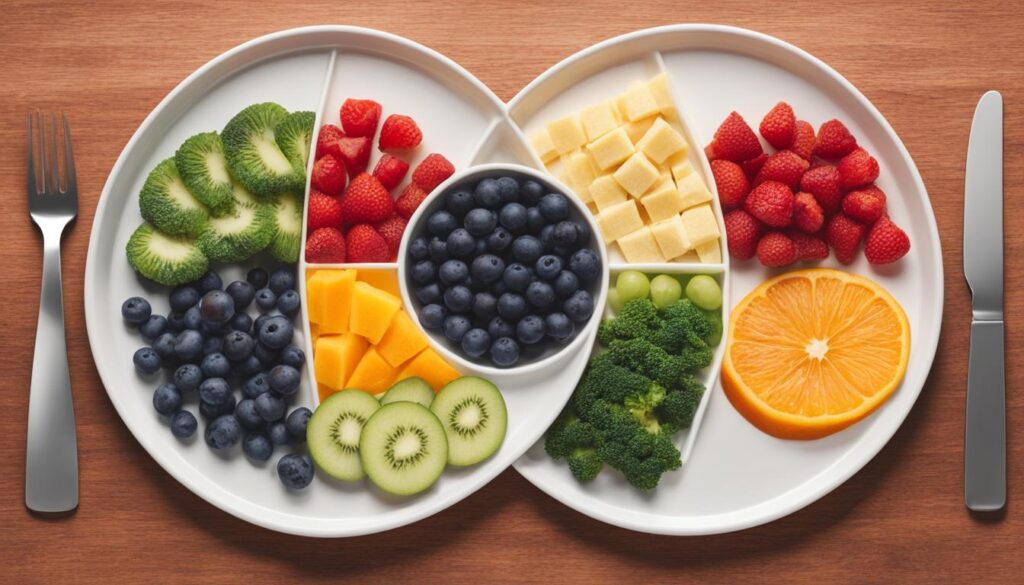
The plate method is a simple and effective strategy for portion control that can help you create balanced meals. By dividing your plate into sections, you can ensure that you’re getting the right proportions of different food groups. Follow these guidelines to implement the plate method:
1. Fill Half with Vegetables
Vegetables should take up half of your plate. They are low in calories and packed with essential nutrients. Aim for a variety of colorful vegetables to maximize nutrient intake. Whether it’s leafy greens, cruciferous vegetables, or root vegetables, they all contribute to a well-balanced meal.
2. Allocate One-Quarter for Lean Protein
Dedicate one-quarter of your plate to lean sources of protein. This can include skinless poultry, fish, tofu, beans, or legumes. Protein is important for muscle repair and growth and can help keep you feeling full and satisfied.
3. Reserve the Remaining Quarter for Whole Grains or Starchy Vegetables
The remaining quarter of your plate should be filled with whole grains or starchy vegetables. This can include options like brown rice, quinoa, whole wheat pasta, sweet potatoes, or corn. These foods provide energy and are a good source of fiber to support digestion.
By following the plate method, you can create a visually appealing and well-rounded meal that promotes portion control and balanced nutrition.
| Benefits of the Plate Method | How the Plate Method Helps |
|---|---|
| Encourages portion control | Dividing the plate helps control portion sizes and prevents overeating. |
| Promotes balanced meals | By including vegetables, lean protein, and whole grains, the plate method ensures a balanced intake of nutrients. |
| Simple and easy to follow | Dividing the plate into sections is a straightforward approach that can be easily incorporated into meal planning. |
| Helps with weight management | Controlling portion sizes and choosing nutrient-dense foods can support weight loss or maintenance goals. |
Conclusion
Mastering meal planning with portion control is essential for maintaining a healthy lifestyle. By implementing strategies like using smaller plates, measuring portions, and being mindful of seconds, you can take charge of your eating habits and achieve a balanced diet. Incorporating portion control into your meal prep routine is a powerful tool for long-term success.
With healthy portion control, you can revolutionize the way you eat. By using smaller plates, our brains perceive standard-sized portions as satisfying, preventing overeating. Measuring cups are a simple yet effective tool for accurately portioning your meals, ensuring consistency in every serving.
Being selective with seconds is a crucial aspect of portion control. Opting for healthier options like fruits instead of high-calorie desserts can help you feel satisfied while keeping your calorie intake in check. It’s also important to check food labels to understand the correct portion sizes and make informed choices.
When dining out, be mindful of supersized portions and practice portion control by saying no to unnecessary extras like bread or chips. Lastly, the plate method is a practical strategy for portion control, helping you create balanced meals by dividing your plate into specific sections.
By following these portion control tips and incorporating them into your meal planning and preparation routine, you can gain control over your portion sizes and make positive changes towards a healthier and more balanced lifestyle. So, start mastering meal planning with portion control today and enjoy the benefits of a healthier you.

